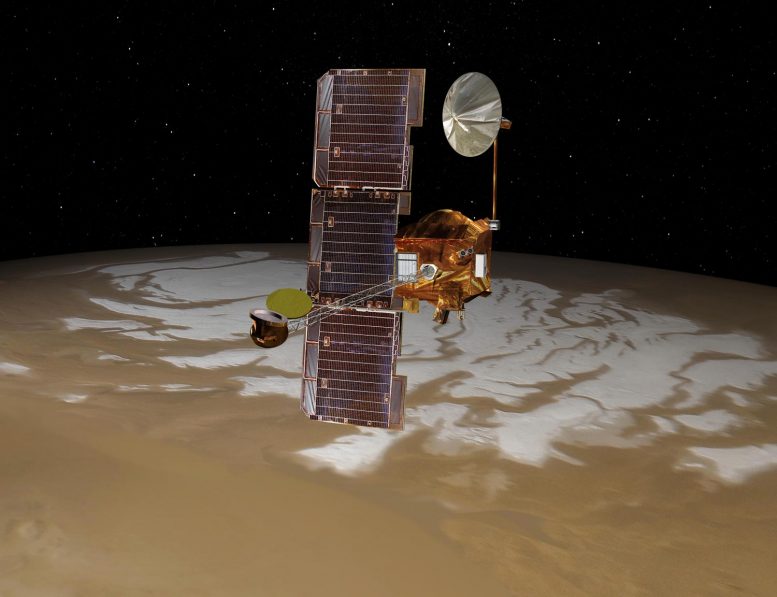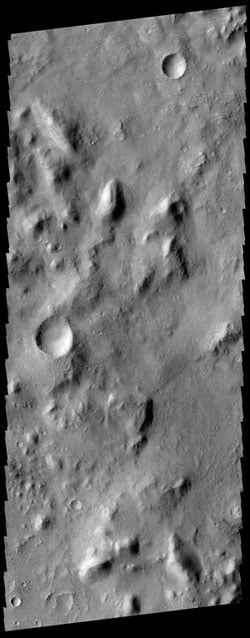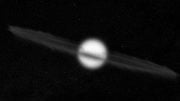
NASA’s Mars Odyssey spacecraft passes above Mars’ south pole in this artist’s concept illustration. The spacecraft has been orbiting Mars since October 24, 2001. Credit: NASA/JPL-Caltech
Ten years and counting. The Thermal Emission Imaging System onboard NASA’s Mars Odyssey orbiter has taken nearly 500,000 images and circled Mars nearly 45,000 times in the last decade and scientists expect many more good years from it.
Ten years ago, on February 19, 2002, the Thermal Emission Imaging System (THEMIS), a multi-band camera on NASA’s Mars Odyssey orbiter, began scientific operations at the Red Planet. Since then the camera has circled Mars nearly 45,000 times and taken more than half a million images at infrared and visible wavelengths.

THEMIS captured this image on February 19, 2012, 10 years to the day after the camera recorded its first view of Mars. This image covers an area 11 by 32 miles (19 by 52 kilometers) in the Nepenthes Mensae region north of the Martian equator. The view depicts a knobby landscape where the southern highlands are breaking up as the terrain descends into the northern lowlands. Credit: NASA/JPL-Caltech/ASU
“THEMIS has proven itself a workhorse,” said Philip Christensen of Arizona State University, Tempe, the camera’s principal investigator and designer. “It’s especially gratifying to me to see the range of discoveries that have been made using this instrument.”
Highlights of science results by THEMIS over the past 10 years include:
- Confirming a mineral exposure selected as the landing site for NASA’s Mars Exploration Rover Opportunity
- Discovering carbon-dioxide gas jets at the south polar ice cap in spring
- Discovering chloride salt deposits across the planet
- Making the best global image map of Mars ever done
- Identifying safe landing sites for NASA’s Mars Phoenix lander by finding the locations with the fewest hazardous boulders
- Monitoring dust activity in the Martian atmosphere
- Discovering that a large crater, Aram Chaos, once contained a lake
- Discovering that Mars has more water-carved channels than previously thought
- Discovering dacite on Mars, a more evolved form of volcanic lava not previously known on the Red Planet
THEMIS combines a five-wavelength visual imaging system with a nine-wavelength infrared imaging system. By comparing daytime and nighttime infrared images of an area, scientists can determine many of the physical properties of the rocks and soils on the ground.
Mars Odyssey has a two-hour orbit that is nearly “sun-synchronous,” meaning that Odyssey passes over the same part of Mars at roughly the same local time each day. In September 2008 its orbit was shifted toward an earlier time of day, which enhanced THEMIS’ mineralogical detection capability.
Says Christensen, “Both Odyssey and THEMIS are in excellent health and we look forward to years more science with them.”
NASA launched the Mars Odyssey spacecraft on April 7, 2001. Odyssey arrived at Mars on October 24, 2001. After arrival, the spacecraft spent several months in a technique called aerobraking, which involved dipping into the Martian atmosphere to adjust its orbit. In February 2002, science operations began.
Odyssey is managed by NASA’s Jet Propulsion Laboratory, Pasadena, for NASA’s Science Mission Directorate in Washington. Lockheed Martin Space Systems in Denver built the spacecraft. JPL and Lockheed Martin collaborate on operating the spacecraft. JPL is a division of the California Institute of Technology in Pasadena.









Be the first to comment on "A Decade Worth of Discovery from THEMIS"